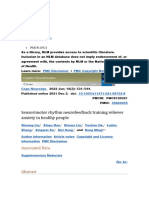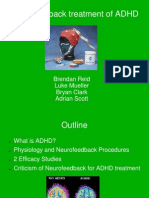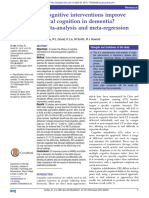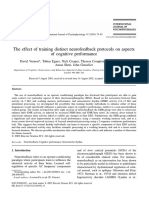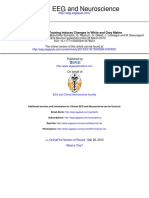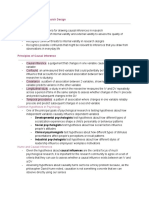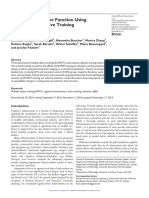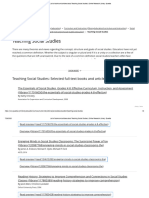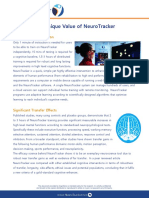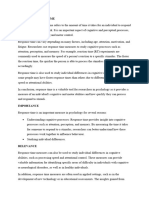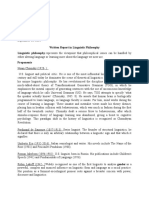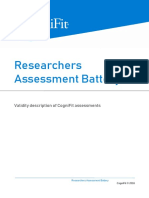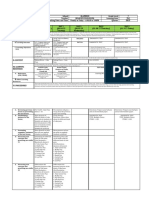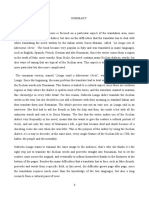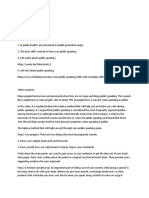The Integration of Neurofeedback and Short-Term Memory Games: Enhancing Cognitive Therapy Outcomes
The Integration of Neurofeedback and Short-Term Memory Games: Enhancing Cognitive Therapy Outcomes
Volume 10, Issue 1, January – 2025 International Journal of Innovative Science and Research Technology
ISSN No:-2456-2165 https://doi.org/10.5281/zenodo.14716974
The Integration of Neurofeedback and Short-Term
Memory Games: Enhancing Cognitive
Therapy Outcomes
Samera Sabbagh
Abstract:- Neurofeedback and short-term memory The complementary nature of these methods suggests
games have each demonstrated notable efficacy in the potential for a synergistic effect: while neurofeedback
enhancing cognitive functions such as memory retention, targets neural regulation and brainwave optimization,
attention span, and overall brain performance. Despite memory games actively engage cognitive processes,
their individual benefits, the integration of these methods potentially reinforcing neuroplasticity.
as a cohesive therapeutic strategy remains
This paper seeks to explore the feasibility and efficacy
underexplored. This study investigates the synergistic
of combining neurofeedback and short-term memory games
potential of combining neurofeedback and short-term as a unified therapeutic strategy. By examining cognitive
memory games in addressing cognitive impairments. improvements among participants undergoing the combined
Fifty participants diagnosed with attention deficits, mild intervention compared to neurofeedback-only therapy, this
cognitive impairment, or recovering from traumatic study aims to highlight the benefits and clinical implications
brain injuries were enrolled and divided into two groups: of this novel approach. Through rigorous assessment using
one receiving neurofeedback-only therapy and another standardized cognitive tests and EEG metrics, we aim to
undergoing a combined intervention. Over eight weeks, contribute to the growing body of research on innovative
the combined therapy group exhibited significantly methods for cognitive rehabilitation and enhancement.
greater improvements in cognitive performance,
including a 35% increase in memory retention, enhanced II. METHODS
attention span, and elevated neuroplasticity indicators.
Participants:
These findings suggest that combining neurofeedback
This study involved 50 participants aged 18–65
and memory games offers a novel, effective, and diagnosed with attention deficits, mild cognitive
engaging approach to cognitive therapy, with promising impairment, or recovering from traumatic brain injuries.
implications for treating ADHD, early-stage Alzheimer’s, Participants were divided into two groups: one undergoing
and post-traumatic recovery. neurofeedback-only therapy and another receiving the
combined therapy.
I. INTRODUCTION
Intervention Design:
Cognitive impairments, ranging from attention deficits The intervention lasted eight weeks, with three 45-
to memory dysfunction, pose significant challenges to minute sessions per week. During each session, participants
individuals and healthcare systems alike. Effective in the combined therapy group:
interventions are essential to address these challenges and
improve quality of life. Neurofeedback, which leverages Engaged in neurofeedback training using EEG to
real-time EEG data to train individuals to regulate monitor and regulate brainwave patterns associated with
brainwave activity, has gained recognition as a non-invasive focus and memory.
and personalized therapeutic tool. Concurrently, short-term Played short-term memory games specifically designed
memory games, known for their ability to enhance working to challenge working memory, such as sequence recall
memory and attention, have long been used to bolster tasks, spatial memory puzzles, and rapid categorization
cognitive abilities in diverse populations. challenges.
Despite their proven individual effectiveness, the Measurement Tools
integration of neurofeedback and short-term memory games Cognitive improvements were assessed using
remains largely unexplored in clinical and research contexts. standardized tools, including the Wechsler Memory Scale
(WMS) and Trail Making Test (TMT). Baseline
measurements were compared to post-intervention scores.
IJISRT25JAN730 www.ijisrt.com 556
Volume 10, Issue 1, January – 2025 International Journal of Innovative Science and Research Technology
ISSN No:-2456-2165 https://doi.org/10.5281/zenodo.14716974
III. RESULTS REFERENCES
The group undergoing the combined therapy exhibited [1]. Arns, M., Heinrich, H., & Strehl, U. (2014). Evaluation
significant improvements in cognitive performance of neurofeedback in ADHD: The long and winding
compared to the neurofeedback-only group: road. Biological Psychology, 95, 108-115.
[2]. Baddeley, A. (1992). Working memory. Science,
Memory Retention: 255(5044), 556-559.
Participants demonstrated a 35% increase in short-term [3]. Klimesch, W. (1999). EEG alpha and theta oscillations
memory retention scores, as measured by the WMS. reflect cognitive and memory performance: A review
and analysis. Brain Research Reviews, 29(2-3), 169-
Attention Span: 195.
TMT results showed a 25% reduction in task [4]. Smith, E. E., & Kosslyn, S. M. (2007). Cognitive
completion time, indicating enhanced focus and cognitive psychology: Mind and brain. Upper Saddle River, NJ:
processing speed. Pearson/Prentice Hall.
[5]. Vernon, D. (2005). Can neurofeedback training
Neuroplasticity Indicators: enhance performance? An evaluation of the evidence
EEG readings suggested increased alpha wave activity, with implications for future research. Applied
associated with relaxation and improved cognitive function. Psychophysiology and Biofeedback, 30(4), 347-364.
IV. DISCUSSION
The results affirm the hypothesis that integrating
neurofeedback and short-term memory games can
synergistically enhance cognitive therapy outcomes.
Neurofeedback’s ability to train brainwave regulation
complements the active engagement required by memory
games, fostering neuroplasticity and cognitive resilience.
Clinical Implications:
This approach has significant potential in treating
conditions such as ADHD, early-stage Alzheimer’s, and
post-traumatic recovery. It also opens avenues for non-
invasive, personalized therapy protocols adaptable to
various age groups and cognitive conditions.
Limitations and Future Research:
While the results are promising, the study’s limited
sample size and short duration warrant further investigation.
Future research should explore long-term effects, the impact
of game design variations, and potential applications in
other cognitive domains.
V. CONCLUSION
The integration of neurofeedback and short-term
memory games represents a ground-breaking advance in
cognitive therapy. By combining the strengths of both
methods, this approach not only enhances memory and
attention but also lays the groundwork for more effective
and engaging therapeutic practices. Further exploration and
refinement could establish this technique as a cornerstone of
neuro-cognitive rehabilitation.
IJISRT25JAN730 www.ijisrt.com 557
You might also like
- Slum Dwellers’ Access to Urban Basic Services: A Study of Two Informal Settlements in Dhaka CityNo ratings yetSlum Dwellers’ Access to Urban Basic Services: A Study of Two Informal Settlements in Dhaka City9 pages
- A Decade of Genome Editing: Comparative Review of ZFN, TALEN, and CRISPR/Cas9No ratings yetA Decade of Genome Editing: Comparative Review of ZFN, TALEN, and CRISPR/Cas910 pages
- Chronic Disease Prevention and Management: Community-Based Approaches and StrategiesNo ratings yetChronic Disease Prevention and Management: Community-Based Approaches and Strategies3 pages
- The Impact of Parental Involvement on the GPA of South Asian American Highschool Students in New JerseyNo ratings yetThe Impact of Parental Involvement on the GPA of South Asian American Highschool Students in New Jersey23 pages
- The Importance of Emotional Stability for Nigerian Women in Political PositionsNo ratings yetThe Importance of Emotional Stability for Nigerian Women in Political Positions21 pages
- Evaluating Customer-Based Brand Equity: A Case Study of the Top 5 Restaurants in BallariNo ratings yetEvaluating Customer-Based Brand Equity: A Case Study of the Top 5 Restaurants in Ballari13 pages
- Astronomical Influences on Seismic Activity and Their Ecological Impacts: A Multidisciplinary ReviewNo ratings yetAstronomical Influences on Seismic Activity and Their Ecological Impacts: A Multidisciplinary Review12 pages
- An Evaluation of the Patients' Access to Adequate Nutritional Screening in a Tertiary Care Hospital in Order to Receive the Proper Dietary GuidelinesNo ratings yetAn Evaluation of the Patients' Access to Adequate Nutritional Screening in a Tertiary Care Hospital in Order to Receive the Proper Dietary Guidelines15 pages
- Attention Deficit Hyperactivity Disorder (Adhd) and Related Learning DisabilitiesNo ratings yetAttention Deficit Hyperactivity Disorder (Adhd) and Related Learning Disabilities171 pages
- An Investigation Into Primary Healthcare Workers' Awareness and Practical Application of The Partograph in Ilorin Metropolis, Kwara State, NigeriaNo ratings yetAn Investigation Into Primary Healthcare Workers' Awareness and Practical Application of The Partograph in Ilorin Metropolis, Kwara State, Nigeria8 pages
- Economic Viability of Sericulture in Comparison to Conventional Crop Cultivation in Korinthakunta Thanda, TelanganaNo ratings yetEconomic Viability of Sericulture in Comparison to Conventional Crop Cultivation in Korinthakunta Thanda, Telangana9 pages
- Digital Epidemiology in Action: A Cross-Platform Review of Social Media and Internet-Based Surveillance for Infectious Disease OutbreaksNo ratings yetDigital Epidemiology in Action: A Cross-Platform Review of Social Media and Internet-Based Surveillance for Infectious Disease Outbreaks9 pages
- Using Recent BCI Literature To Deepen Our Understanding of Clinical Neurofeedback (Book)No ratings yetUsing Recent BCI Literature To Deepen Our Understanding of Clinical Neurofeedback (Book)24 pages
- Customer Perception and Service Quality - A Comparative Study Among Traditional and Neo BanksNo ratings yetCustomer Perception and Service Quality - A Comparative Study Among Traditional and Neo Banks7 pages
- The Problem of Youth Entrepreneurship Development in KyrgyzstanNo ratings yetThe Problem of Youth Entrepreneurship Development in Kyrgyzstan7 pages
- Amplifying the Importance of Synchronic- Diachronic Approaches in Social Sciences Research: Unleashing the Power of this Technique for Better Sociocultural AnalysisNo ratings yetAmplifying the Importance of Synchronic- Diachronic Approaches in Social Sciences Research: Unleashing the Power of this Technique for Better Sociocultural Analysis6 pages
- Administrative Gatekeeping and Informal Hierarchies: Exploring Role Ambiguity and Power Dynamics Between Head Office and Peripheral Staff in the Public SectorNo ratings yetAdministrative Gatekeeping and Informal Hierarchies: Exploring Role Ambiguity and Power Dynamics Between Head Office and Peripheral Staff in the Public Sector6 pages
- Effect of Broadcast Media in Mobilising the People for Enrolment of National Identification Number (NIN)No ratings yetEffect of Broadcast Media in Mobilising the People for Enrolment of National Identification Number (NIN)4 pages
- Non-Verbal Communication to Enhance Learning: Strategies of Filipino Language TeachersNo ratings yetNon-Verbal Communication to Enhance Learning: Strategies of Filipino Language Teachers4 pages
- Inquiry and Action Research For Early Grade, Upper Prim. and Jhs CompleteNo ratings yetInquiry and Action Research For Early Grade, Upper Prim. and Jhs Complete206 pages
- Extraction of Balanites aegyptiaca Seed Oil and Its Application in Soap Production from the Wood AshNo ratings yetExtraction of Balanites aegyptiaca Seed Oil and Its Application in Soap Production from the Wood Ash5 pages
- Balancing Continuous Service and Budget Constraints: A Comparative Analysis of Shift Systems in Public Agricultural Services and Private Sector OperationsNo ratings yetBalancing Continuous Service and Budget Constraints: A Comparative Analysis of Shift Systems in Public Agricultural Services and Private Sector Operations5 pages
- Engineering-Economic Comparison of Grid-Tied and Standalone Solar Energy Solutions For Sustainable Rural ElectrificationNo ratings yetEngineering-Economic Comparison of Grid-Tied and Standalone Solar Energy Solutions For Sustainable Rural Electrification9 pages
- A Study On The Structural and Tensile Behaviour of Tasar and Eri Spun Silk YarnsNo ratings yetA Study On The Structural and Tensile Behaviour of Tasar and Eri Spun Silk Yarns9 pages
- The Effect of Technological Advances on Music in TunisiaNo ratings yetThe Effect of Technological Advances on Music in Tunisia4 pages
- Angelman Syndrome: An Updated Review of Pathophysiology, Diagnosis and ManagementNo ratings yetAngelman Syndrome: An Updated Review of Pathophysiology, Diagnosis and Management6 pages
- Kallio Et Al 2017 Cognitive Training Interventions For Patients With Alzheimer S Disease A Systematic ReviewNo ratings yetKallio Et Al 2017 Cognitive Training Interventions For Patients With Alzheimer S Disease A Systematic Review24 pages
- Ecological and Human Health of Polychlorinated Biphenyls (PCBs) Across Tide and Saline Influenced Hydrocarbon Mining Zones of Tropical Deltaic Wetlands, Southern NigeriaNo ratings yetEcological and Human Health of Polychlorinated Biphenyls (PCBs) Across Tide and Saline Influenced Hydrocarbon Mining Zones of Tropical Deltaic Wetlands, Southern Nigeria12 pages
- Evaluating the Effectiveness of Lean Management in Agriculture: The Case of Nature’s Gift Banana Farm, Lilongwe, MalawiNo ratings yetEvaluating the Effectiveness of Lean Management in Agriculture: The Case of Nature’s Gift Banana Farm, Lilongwe, Malawi5 pages
- Pearls Analysis of Saving and Credit Cooperatives of JhapaNo ratings yetPearls Analysis of Saving and Credit Cooperatives of Jhapa55 pages
- A Smart Integrated System for Milk Collection & DispensingNo ratings yetA Smart Integrated System for Milk Collection & Dispensing5 pages
- The Role of Human Capital Development and Financial Deepening in Nigeria’s Industrial OutputNo ratings yetThe Role of Human Capital Development and Financial Deepening in Nigeria’s Industrial Output14 pages
- Synchronizing Brain Rhytms To Improve CognitionNo ratings yetSynchronizing Brain Rhytms To Improve Cognition19 pages
- Creativity and Artificial Intelligence A Conceptual Blending Approach Applications of Cognitive Linguistics 1st Edition Cã Mara PereiraNo ratings yetCreativity and Artificial Intelligence A Conceptual Blending Approach Applications of Cognitive Linguistics 1st Edition Cã Mara Pereira67 pages
- Cortese Et Al (2016) Neurofeedback in ADHD - Meta-AnalysisNo ratings yetCortese Et Al (2016) Neurofeedback in ADHD - Meta-Analysis43 pages
- Golino Et Al-2016-Revista Brasileira de Geriatria e GerontologiaNo ratings yetGolino Et Al-2016-Revista Brasileira de Geriatria e Gerontologia17 pages
- Responding and Identifying To Developmental Delay in ChildrenNo ratings yetResponding and Identifying To Developmental Delay in Children14 pages
- Art of Remediating Agerelated Cognitive Decline Art Therapy Enhances Cognition and Increases Cortical Thickness in Mild Cognitive ImpairmentNo ratings yetArt of Remediating Agerelated Cognitive Decline Art Therapy Enhances Cognition and Increases Cortical Thickness in Mild Cognitive Impairment10 pages
- General Domains of Teaching Competence - 1No ratings yetGeneral Domains of Teaching Competence - 183 pages
- Efectiveness of Computer-Based Interventions For Community-Dwelling PeopleNo ratings yetEfectiveness of Computer-Based Interventions For Community-Dwelling People20 pages
- Effectiveness of Cognitive Interventions in Older Adults A ReviewNo ratings yetEffectiveness of Cognitive Interventions in Older Adults A Review23 pages
- 2020 The Design, Evaluation, and Reporting On Non-PharmacologicalNo ratings yet2020 The Design, Evaluation, and Reporting On Non-Pharmacological16 pages
- Direct Neural Stimulation for Learning: A Simple Guide to Big IdeasFrom EverandDirect Neural Stimulation for Learning: A Simple Guide to Big IdeasNo ratings yet
- TP 2024A Teamwork Competency and Satisfaction in Online GroupNo ratings yetTP 2024A Teamwork Competency and Satisfaction in Online Group12 pages
- (Series in Affective Science) Jodi Quas, Robyn Fivush-Emotion in Memory and Development - Biological, Cognitive, and Social Considerations - Oxford University Press, USA (2009) PDF100% (2)(Series in Affective Science) Jodi Quas, Robyn Fivush-Emotion in Memory and Development - Biological, Cognitive, and Social Considerations - Oxford University Press, USA (2009) PDF449 pages
- Neurofeedback Treatment of ADHD: Brendan Reid Luke Mueller Bryan Clark Adrian ScottNo ratings yetNeurofeedback Treatment of ADHD: Brendan Reid Luke Mueller Bryan Clark Adrian Scott33 pages
- Meta-Analysis of Memory-Focused Training and Multidomain Interventions in MCI, 2020, Sherman DaleNo ratings yetMeta-Analysis of Memory-Focused Training and Multidomain Interventions in MCI, 2020, Sherman Dale23 pages
- Effect of Interactive Multitouch Game-Based CognitiveNo ratings yetEffect of Interactive Multitouch Game-Based Cognitive11 pages
- Padakannaya, Puvia, Khalil - Editorial - Frontiers Nov 2023No ratings yetPadakannaya, Puvia, Khalil - Editorial - Frontiers Nov 20233 pages
- Complementary Therapies in Medicine: Kim E. Innes, Terry Kit Selfe, Dharma Singh Khalsa, Sahiti KandatiNo ratings yetComplementary Therapies in Medicine: Kim E. Innes, Terry Kit Selfe, Dharma Singh Khalsa, Sahiti Kandati10 pages
- Advancing Computerized Cognitive Training For Early Alzheimer's Disease in A Pandemic and Post-Pandemic WorldNo ratings yetAdvancing Computerized Cognitive Training For Early Alzheimer's Disease in A Pandemic and Post-Pandemic World8 pages
- A Multicenter Effectiveness Trial of QEEG-informed Neurofeedback in ADHD - Replication and Treatment PredictionNo ratings yetA Multicenter Effectiveness Trial of QEEG-informed Neurofeedback in ADHD - Replication and Treatment Prediction9 pages
- Advances in Non-Invasive Neuromodulation Techniques For Improving Cognitive Function - A Review - Brainsci-14-00354No ratings yetAdvances in Non-Invasive Neuromodulation Techniques For Improving Cognitive Function - A Review - Brainsci-14-003542 pages
- Health - Day 3 - G8-Dlltemplate-2023-2024No ratings yetHealth - Day 3 - G8-Dlltemplate-2023-20246 pages
- The Effect of Training Distinct Neurofeedback Protocols On Aspects of Cognitive PerformanceNo ratings yetThe Effect of Training Distinct Neurofeedback Protocols On Aspects of Cognitive Performance11 pages
- 2018 - Efficacy of Cognitive Rehabilitation in Alzheimer Disease - A 1-Year Follow-Up StudyNo ratings yet2018 - Efficacy of Cognitive Rehabilitation in Alzheimer Disease - A 1-Year Follow-Up Study8 pages
- Enhancing Cognitive Function Using Perceptual-Cognitive TrainingNo ratings yetEnhancing Cognitive Function Using Perceptual-Cognitive Training11 pages
- Approaches and Methods in Language Teaching100% (1)Approaches and Methods in Language Teaching18 pages
- List of Books and Articles About Teaching Social Studies - Online Research Library - QuestiaNo ratings yetList of Books and Articles About Teaching Social Studies - Online Research Library - Questia6 pages
- The Extent of Pressure Among Grade 11 STEM Students in Relation To TheNo ratings yetThe Extent of Pressure Among Grade 11 STEM Students in Relation To The4 pages
- The Unique Value of NeuroTracker 2016.06.02No ratings yetThe Unique Value of NeuroTracker 2016.06.026 pages
- Written Report in Linguistic Philosophy Linguistic Philosophy Represents The Viewpoint That Philosophical Issues Can Be Handled by ProponentsNo ratings yetWritten Report in Linguistic Philosophy Linguistic Philosophy Represents The Viewpoint That Philosophical Issues Can Be Handled by Proponents4 pages
- ADD Efficacy of Neurofeedback On Adults With ADDNo ratings yetADD Efficacy of Neurofeedback On Adults With ADD6 pages
- Glafjenhs 7 Jhoanne L.Raranggol TLE Monday To Friday - 6:00AM To 3:00PM FirstNo ratings yetGlafjenhs 7 Jhoanne L.Raranggol TLE Monday To Friday - 6:00AM To 3:00PM First4 pages
- April 2017 CAIE P2 Questions 1110 English As A Second Language Cambridge Lower Secondary CheckpointNo ratings yetApril 2017 CAIE P2 Questions 1110 English As A Second Language Cambridge Lower Secondary Checkpoint8 pages
- Neurofeedback: Is There A Potential For Use in Education?No ratings yetNeurofeedback: Is There A Potential For Use in Education?12 pages
- Marianna Ucrìa". The Book Became Very Popular in Italy and Was Translated in Many LanguagesNo ratings yetMarianna Ucrìa". The Book Became Very Popular in Italy and Was Translated in Many Languages1 page
- Orenaiya Solomon Adewale (MR), Adenowo, E.Adeleke (MR), Aroyeun Funlola Toyin (MRS.), Odusoga Rotimi (MR)No ratings yetOrenaiya Solomon Adewale (MR), Adenowo, E.Adeleke (MR), Aroyeun Funlola Toyin (MRS.), Odusoga Rotimi (MR)7 pages
- 8 Stylistics As A Branch of General Linguistics0% (1)8 Stylistics As A Branch of General Linguistics6 pages
- Name: Krizah Marie C. Caballero Course & Section: BSA 1A: Reaction PaperNo ratings yetName: Krizah Marie C. Caballero Course & Section: BSA 1A: Reaction Paper1 page








































